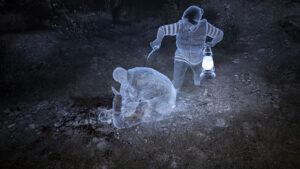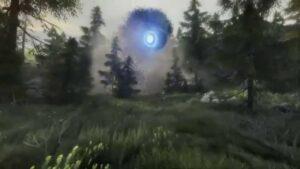The Vanishing of Ethan Carter, developed by The Astronauts, is a mystery horror game that blends both narrative and mechanics to create a super immersive gameplay experience. You play as Paul Prospero, a detective with the ability to see into the past, who’s searching for a missing boy, Ethan Carter, in Red Creek Valley.
“The Vanishing of Ethan Carter’s greatest strength is its commitment to weaving its story directly into the environment around you through environmental puzzles that really push the narrative forward. Solving puzzles isn’t just about getting to the next stage; it reveals parts of the story. For instance, when I started piecing together the layout of the burnt-down house, it not only was mentally challenging, but it also plunged me deeper into the tragic history of the Carter family. This approach, where the environment itself is a puzzle, I found really deepened my connection to the story.
Compared to other mystery games like Gone Home or Dear Esther, The Vanishing of Ethan Carter stood out to me because of its supernatural, interactive elements. The other games do use puzzles to tell a story, but Ethan Carter takes it a step further with puzzles that directly tie into the supernatural and the spooky environment, which definitely enhanced the mystery and engagement for me.
Red Creek Valley isn’t just a backdrop; it’s a full-fledged character in its own right. The setting, with its decaying structures and stunning landscapes, mirrors the game’s themes of loss and mystery. I enjoyed that the game let me explore areas in any order, which is great for curiosity but can also be a bit overwhelming without any guidance. However, it seems like the developers are aware of this, and really capitalize on it when it most counts. In fact, one of my favorite aspects of the gameplay was that the game doesn’t babysit the player. From the start, it’s up to me to explore and connect the dots. This hands-off approach makes every discovery feel earned and keeps me totally immersed. At times, I was definitely lost, but I’m sure some level of confusion was intentional, since I found standing/wandering around alone in the Valley only added to the immersion.
One particularly memorable moment in the game for me was early on when I discovered a bloodied/disfigured body by the railroad tracks. This scene sets the stage for the game’s investigative mechanics, as here I ended up using Paul’s supernatural powers to reconstruct the crime scene. Once again, I love how the developers utilize the environment in subtly revealing ways. For example, a blood-stained rock, disturbed gravel, and a rope tied across the tracks all were small clues that helped piece together the story. And right as I correctly aligned the clues, I witnessed ghostly vignettes that replayed the tragic events of the victim’s death. Here, I felt rewarded for my curiosity, and I found myself only further engaged/captivated by the storyline. It not only deepened the mystery, but also immersed me further into the detective role, making me feel like a real investigator piecing together a complex puzzle.
Another intriguing aspect of the game that adds to its mysterious atmosphere is the way it handles the supernatural elements, particularly through Ethan’s stories scattered around the valley. These stories, found in written notes or as scenes reenacted by ethereal figures, weave a secondary layer of narrative. One story I found involves a space capsule buried underground that immediately triggered this surreal, otherworldly sequence. This was not only a stark contrast to the naturalistic setting from the rest of the game, but it also blurred the lines between Ethan’s imagination and what’s actually happening in Red Creek Valley. At that moment, I didn’t actually know what to believe, so I feel like these moments are crucial in a mystery game. It forces/compels players to question what is real and what is a product of Ethan’s creative mind, urging me to delve deeper into the secrets of the world to solve the mystery.
This approach of setting up an extremely interactive/immersive world sets it apart in the mystery genre, but I still think some gameplay aspects could be smoother to avoid frustration. While I love the freedom the game offers, sometimes it can lead to confusion, especially with the game’s save system and lack of direction. A simple logbook or even just a more intuitive hint system would keep the freedom intact while smoothing out some of the rough edges in navigation (I got frustrated sometimes).
The Vanishing of Ethan Carter shows just how powerful video games can be in telling stories through environment and gameplay. It’s a game that doesn’t just tell a story—it let me live it. Improving some of the navigational aids would make it even better, but as it stands, it’s a great blend of narrative depth and freedom of exploration that’s rare in walking/mystery games today. For anyone who loves unraveling a story at their own pace, this game is a must-play.




